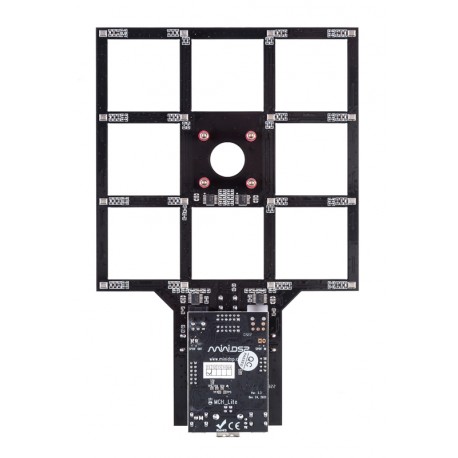












16 channels Low cost USB microphone array, Uniform Rectangular Array (URA), 16 x raw audio ASIO driver, perfect for a DIY acoustic camera, USB to PDM interface for up to 16 x MEMS
The UMA-16 v2 is the updated version of our sixteen-channel microphone array with plug&play USB audio connectivity. With its onboard XMOS interface, the UMA-16 is the perfect fit for the development of beam-forming algorithms or your DIY acoustic camera. Its system architecture consists of two core elements:
- A microphone PCB with 16 x Knowles SPH1668LM4H MEMS microphones in a uniform rectangular array (URA). A center hole fits an optional USB camera for applications such as acoustic cameras. The microphone PCB is a simple 2-layer design that can easily be customized to your needs by following our schematics included in the user manual.
- Stacked on top of the mic array is the MCHStreamer Lite USB interface. This XMOS XCORE interface allows for a high quality PDM to PCM conversion and presents all 16 channels of raw audio to the USB interface.
Features
| Item | Description |
| USB audio input |
XMOS Xcore200 asynchronous USB audio up to 48 kHz, USB Audio Class 2 compliant
|
| PDM inputs | Up to 16 x MEMS microphone connections (8 x stereo PDM data lines) |
| MEMS microphone | 16 x SPH1668LM4H - Acoustic Overload @ 120dBSPL / High SNR of 65dB / RF shielded |
| ADC/DAC Sample rate & Resolution |
Resolution: 24 bit |
| USB port | USB port type Mini-B for audio streaming and firmware upgrade |
| Power supply | USB powered |
| Dimensions (H x W x D) mm | 132 x 202 x 18 mm |
| Mounting | 4 x M3 holders for front panel mounting / CAD drawings available on demand |
The miniDSP UMA-16 & UMA-8 microphone arrays are low cost USB microphone arrays and the perfect fit for software developpers looking for a plug&play USB audio interface. Thanks to their RAW/Unprocessed audio multichannel capability, one can test/develop beamforming or AEC algorithms in a very short time within Matlab. In this app note we'll showcase an example on how to discover the UMA-16/UMA-8 within Matlab. For non commercial applications, we recommend Matlab Home (only 99USD at time of writing) as a very powerful & affordable solution to get started!
Important note: While this app note showcases how to discover the UMA-16 within Matlab environment, we'd like to highlight that our team will not be providing any tech support for custom Matlab applications. Please contact Matlab technical support/community.
As a software/firmware or hardware engineer, building a microphone array that easily interfaces with your development environment isn't always straightforward. System design, schematics, layout, prototyping will seriously slowdown your ability to focus on what may matter the most: software and product development. That is actually the reason why miniDSP engineered the UMA-8 and UMA-16! As our team struggled ways to quickly develop proof of concepts for new mic arrangements, we built the UMA16. A two-board design with a brain (XMOS + SHARC doing PDM to PCM to USB conversion) and a low cost 2layer MEMS PCB stacked on top. Want to modify the arrangement? Sure, we've provided all schematics to get you started!

Plug the supplied USB cable into the miniUSB port on the UMA-16, and plug the other end into a spare USB port on your PC/Mac. Plug the 12V external power supply.
Inside Matlab, you can define your recording interface using the device reader object. More info on this object can be found here.
fs = 48000;
audioFrameLength = 1024;
deviceReader = audioDeviceReader(...
'Device', 'miniDSP ASIO Driver',...
'Driver', 'ASIO', ...
'SampleRate', fs, ...
'NumChannels', 16 ,...
'OutputDataType','double',...
'SamplesPerFrame', audioFrameLength);
Notice how the UMA-8/16 will be discovered as "miniDSP ASIO Driver". Make sure that you use ASIO for your definition as standard WDM recording object won't be working.
That's all, you now have real time audio within your environment! Time to get started on your coding. :)
To get you started in your development, here are few links to some great resources. Please send us more examples/comments so we can populate this list!
While this example isn't 100% similar (linear vs rectangular/circular array), the concepts of live/recorded are very much applicable and could be a great starting point for your project.

Similar to the above example, here is a great app note with examples on how to make use of the real time audio libraries within Matlab.

A great starting point to understand how geometry will affect the performance of your array is ploting the Grating Lobe diagram showing the positions of the peaks of the narrowband array pattern. The array pattern depends only upon the geometry of the array and not upon the types of elements which make up the array. Visible and nonvisiblegrating lobes are displayed as open circles.

It's the structure of the UMA-16 so you may as well learn to use this toolbox! Check out examples here and do note that the indexing is different from the miniDSP channel assignment.

Не удаётся отправить вашу оценку отзыва
Пожаловаться на комментарий
Жалоба отправлена
Не удаётся отправить вашу жалобу
Оставьте свой отзыв
Отзыв отправлен
Не удаётся отправить отзыв

16 channels Low cost USB microphone array, Uniform Rectangular Array (URA), 16 x raw audio ASIO driver, perfect for a DIY acoustic camera, USB to PDM interface for up to 16 x MEMS
check_circle
check_circle
